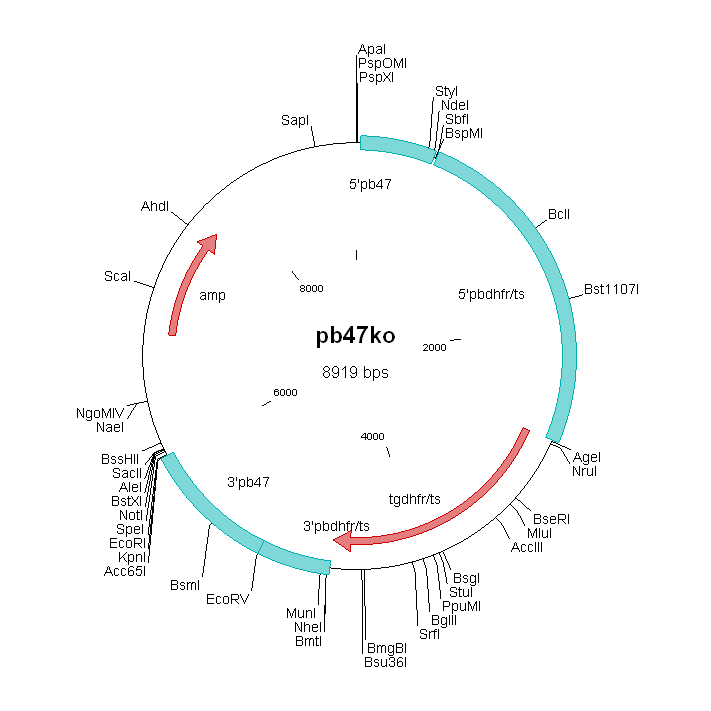SummaryRMgm-348
|
||||||||
 *RMgm-348
*RMgm-348| Successful modification | The parasite was generated by the genetic modification | ||||||||||||||||||||||||
| The mutant contains the following genetic modification(s) | Gene disruption | ||||||||||||||||||||||||
| Reference (PubMed-PMID number) |
Reference 1 (PMID number) : 20386715 | ||||||||||||||||||||||||
| MR4 number |
MRA-870 | ||||||||||||||||||||||||
| top of page | |||||||||||||||||||||||||
| Parent parasite used to introduce the genetic modification | |||||||||||||||||||||||||
| Rodent Malaria Parasite | P. berghei | ||||||||||||||||||||||||
| Parent strain/line | P. berghei ANKA | ||||||||||||||||||||||||
| Name parent line/clone | P. berghei ANKA cl15cy1 | ||||||||||||||||||||||||
| Other information parent line | A reference wild type clone from the ANKA strain of P. berghei (PubMed: PMID: 17406255). | ||||||||||||||||||||||||
| top of page | |||||||||||||||||||||||||
| The mutant parasite was generated by | |||||||||||||||||||||||||
| Name PI/Researcher | M.R. van Dijk; C.J. Janse | ||||||||||||||||||||||||
| Name Group/Department | Leiden Malaria Research Group | ||||||||||||||||||||||||
| Name Institute | Leiden University Medical Center | ||||||||||||||||||||||||
| City | Leiden | ||||||||||||||||||||||||
| Country | The Netherlands | ||||||||||||||||||||||||
| top of page | |||||||||||||||||||||||||
| Name of the mutant parasite | |||||||||||||||||||||||||
| RMgm number | RMgm-348 | ||||||||||||||||||||||||
| Principal name | 270cl1; 526cl1 | ||||||||||||||||||||||||
| Alternative name | Δp47 | ||||||||||||||||||||||||
| Standardized name | |||||||||||||||||||||||||
| Is the mutant parasite cloned after genetic modification | Yes | ||||||||||||||||||||||||
| top of page | |||||||||||||||||||||||||
| Phenotype | |||||||||||||||||||||||||
| Asexual blood stage | Not different from wild type | ||||||||||||||||||||||||
| Gametocyte/Gamete | Normal numbers of male and female gametocytes are produced. Male and female gamete formation is normal(escape from host red blood cell, formation of 8 motile male gametes). Female gametes are strongly affected in their fertility, resulting in nearly complete inhibition of ookinete formation in vitro (>0.99%). Motile males fail to attach to and penetrate female gametes. Mutant male gametes are fertile as shown by cross-fertilisation with wild type female gametes. | ||||||||||||||||||||||||
| Fertilization and ookinete | Female gametes are strongly affected in their fertility, resulting in nearly complete inhibition of ookinete formation in vitro (>0.99%). Motile males fail to attach to and penetrate female gametes. Mutant male gametes are fertile as shown by cross-fertilisation with wild type female gametes. Mutant parasites produce low numbers of ookinetes in vivo (Anopheles stephensi). See also 'Additional remarks phenotype'. | ||||||||||||||||||||||||
| Oocyst | Not different from wild type | ||||||||||||||||||||||||
| Sporozoite | Not different from wild type | ||||||||||||||||||||||||
| Liver stage | Not different from wild type | ||||||||||||||||||||||||
| Additional remarks phenotype | Mutant/mutation The mutant shows very low levels of fertilization with higher fertilization rates in the mosquito than in in vitro ookinete cultures. Mutant parasites produce low numbers of ookinetes and oocysts in Anopheles stephensi mosquitoes (see also the phenotype description 'Fertilization and ookinete'). Both the ookinetes and oocysts show a normal morphology and oocysts produce normal numbers of sporozoites that are infectious to mice.
| ||||||||||||||||||||||||
 Disrupted: Mutant parasite with a disrupted gene
Disrupted: Mutant parasite with a disrupted gene| top of page | |||||||||||||||||||||||||
| Details of the target gene | |||||||||||||||||||||||||
| Gene Model of Rodent Parasite | PBANKA_1359700 | ||||||||||||||||||||||||
| Gene Model P. falciparum ortholog | PF3D7_1346800 | ||||||||||||||||||||||||
| Gene product | 6-cysteine protein | ||||||||||||||||||||||||
| Gene product: Alternative name | P47; Pfs47 | ||||||||||||||||||||||||
| top of page | |||||||||||||||||||||||||
| Details of the genetic modification | |||||||||||||||||||||||||
| Inducable system used | No | ||||||||||||||||||||||||
| Additional remarks inducable system | |||||||||||||||||||||||||
| Type of plasmid/construct used | Plasmid double cross-over | ||||||||||||||||||||||||
| PlasmoGEM (Sanger) construct/vector used | No | ||||||||||||||||||||||||
| Modified PlasmoGEM construct/vector used | No | ||||||||||||||||||||||||
| Plasmid/construct map |
 | ||||||||||||||||||||||||
| Plasmid/construct sequence |
  GGGCCCCCCCTCGAGGTCGACGGTATCGATAAGCTTGGATCCGATTATAATATTCCTTCA
| ||||||||||||||||||||||||
| Restriction sites to linearize plasmid | BamHI, KpnI | ||||||||||||||||||||||||
| Partial or complete disruption of the gene | Partial | ||||||||||||||||||||||||
| Additional remarks partial/complete disruption | The 5'UTR and 260bp of the coding region remain intact. | ||||||||||||||||||||||||
| Selectable marker used to select the mutant parasite | tgdhfr | ||||||||||||||||||||||||
| Promoter of the selectable marker | pbdhfr | ||||||||||||||||||||||||
| Selection (positive) procedure | pyrimethamine | ||||||||||||||||||||||||
| Selection (negative) procedure | No | ||||||||||||||||||||||||
| Additional remarks genetic modification | |||||||||||||||||||||||||
| Additional remarks selection procedure | |||||||||||||||||||||||||
|
Primer information: Primers used for amplification of the target sequences
 Primer information: Primers used for amplification of the target sequences

| |||||||||||||||||||||||||
| top of page | |||||||||||||||||||||||||

